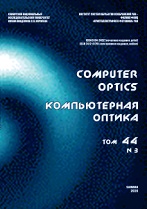|
This article is cited in 3 scientific papers (total in 3 papers)
OPTO-IT
Measurement of the orbital angular momentum of an astigmatic Hermite–Gaussian beam
V. V. Kotlyarab, A. A. Kovalevba, A. P. Porfirevab
a Samara National Research University, Moskovskoye Shosse 34, 443086, Samara, Russia
b IPSI RAS – Branch of the FSRC “Crystallography and Photonics” RAS, Molodogvardeyskaya 151, 443001, Samara, Russia
Abstract:
Here we study three different types of astigmatic Gaussian beams, whose complex amplitude in the Fresnel diffraction zone is described by the complex argument Hermite polynomial of the order (n, 0). The first type is a circularly symmetric Gaussian optical vortex with and a topological charge n after passing through a cylindrical lens. On propagation, the optical vortex "splits" into n first-order optical vortices. Its orbital angular momentum per photon is equal to n. The second type is an elliptical Gaussian optical vortex with a topological charge n after passing through a cylindrical lens. With a special choice of the ellipticity degree (1: 3), such a beam retains its structure upon propagation and the degenerate intensity null on the optical axis does not “split” into n optical vortices. Such a beam has fractional orbital angular momentum not equal to n. The third type is the astigmatic Hermite-Gaussian beam (HG) of order (n, 0), which is generated when a HG beam passes through a cylindrical lens. The cylindrical lens brings the orbital angular momentum into the original HG beam. The orbital angular momentum of such a beam is the sum of the vortex and astigmatic components, and can reach large values (tens and hundreds of thousands per photon). Under certain conditions, the zero intensity lines of the HG beam "merge" into an n-fold degenerate intensity null on the optical axis, and the orbital angular momentum of such a beam is equal to n. Using intensity distributions of the astigmatic HG beam in foci of two cylindrical lenses, we calculate the normalized orbital angular momentum which differs only by 7 % from its theoretical orbital angular momentum value (experimental orbital angular momentum is –13,62, theoretical OAM is –14.76).
Keywords:
orbital angular momentum, Hermite-Gaussian beam, astigmatism, cylindrical lens, Hermite polynomial.
Received: 15.02.2019
Accepted: 02.04.2019
Citation:
V. V. Kotlyar, A. A. Kovalev, A. P. Porfirev, “Measurement of the orbital angular momentum of an astigmatic Hermite–Gaussian beam”, Computer Optics, 43:3 (2019), 356–367
Linking options:
https://www.mathnet.ru/eng/co654 https://www.mathnet.ru/eng/co/v43/i3/p356
|

|




 Contact us:
Contact us: Terms of Use
Terms of Use
 Registration to the website
Registration to the website Logotypes
Logotypes








 Citation in format
Citation in format 
